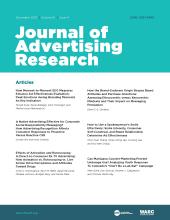Abstract
Existing literature compares neuromarketing and traditional methods, making the questionable assumption that these are monolithic measurement alternatives all serving the same, predictive purpose. This study examines and empirically challenges this notion by relying on a neuroscientific perspective and a robust empirical study to examine the correspondence of expanded sets of diverse electroencephalogram (EEG) and survey advertising indicators. The key findings are that EEG and survey indicators measure different kinds of emotions (and attention) and that the newly developed, momentary EEG indicators are superior to the conventional, aggregated ones. The findings suggest that moment-to-moment EEG advertising indicators, such as peak emotions during branding moments, distinctively enhance advertising effectiveness evaluation and enhancement.
- Received October 12, 2019.
- Received (in revised form) February 12, 2021.
- Accepted March 9, 2021.
- Copyright © 2021 ARF. All rights reserved.
ARF MEMBERS
If you are a member of the Advertising Research Foundation, you can access the content by logging in here
Log In
Pay Per Article - You may access this article (from the computer you are currently using) for 30 days for US$20.00
Regain Access - You can regain access to a recent Pay per Article purchase if your access period has not yet expired.







